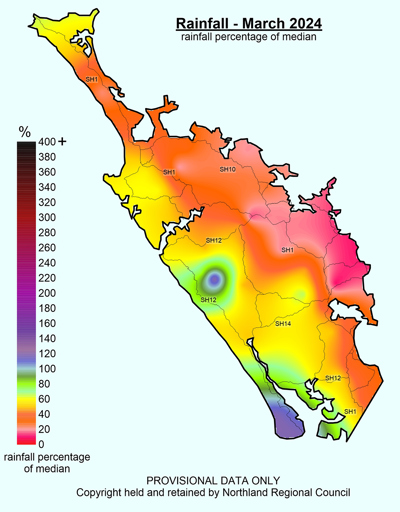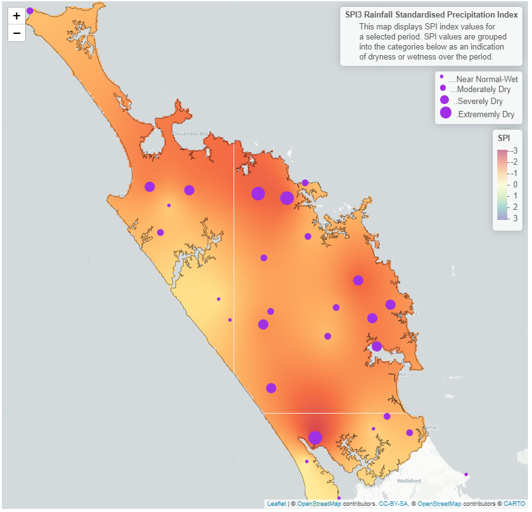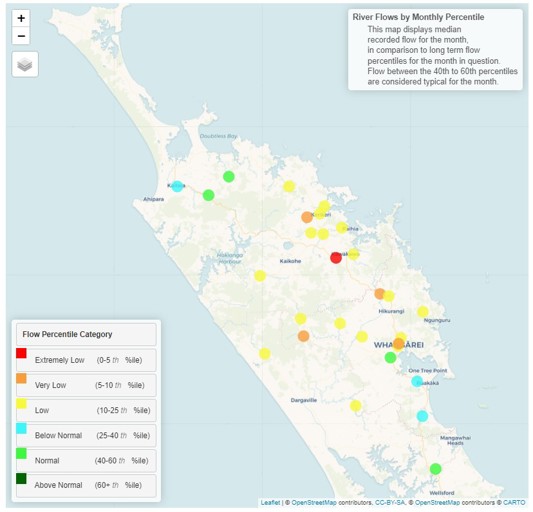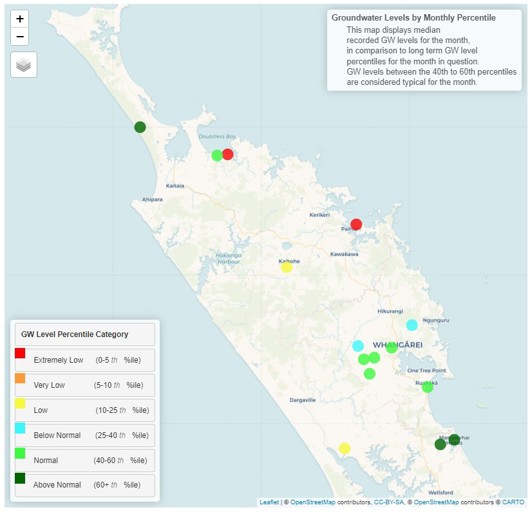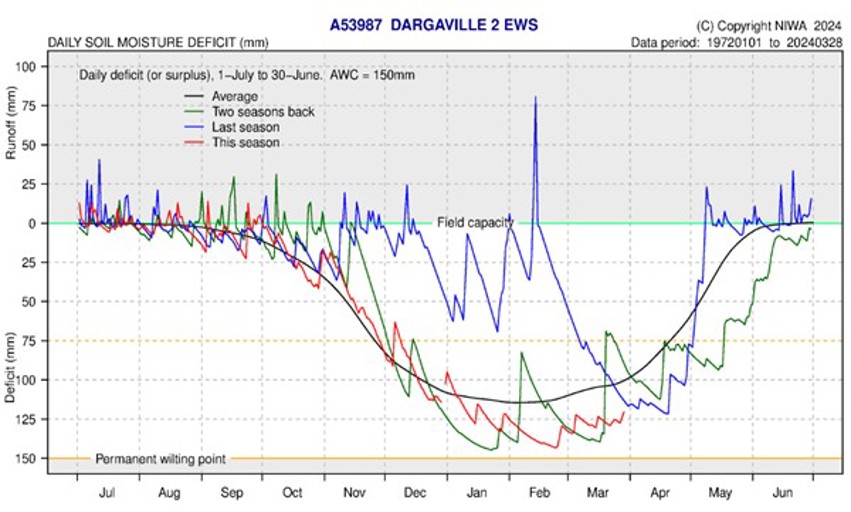March 2024 climate report
4 Apr 2024, 12:00 PM
Summary
- The El Niño has continued to weaken through March and is expected to reach Neutral conditions in Winter.
- Throughout April – June the climate is likely to be “drier than normal” with westerly and south westly winds domination, while temperatures are expected to be “above average”.
- Rainfall in March was below average for the region, 44%, with a range from 11% on the east coast – 120% in Tutamoe.
- River flows are generally low in all catchments across Northland.
- Groundwater levels are variable with Whangārei catchments “normal” for March and other areas “low”.
- Soil Moisture levels are below average for all areas of Northland with plant stress likely occurring.
Climate outlook for April to June 2024
During March El Niño began to weaken, along with stronger than average trade winds, which is expected to continue through April – June. There is an early indication that La Niña could develop next Spring. The Madden-Julian Oscillation (MJO) is currently weakening around New Zealand leading to higher pressure throughout April, and is expected to move into the west in May and June, favouring south-westerly winds and drier conditions in Northland. There is a chance of rainfall in late April, however the same climatic conditions in March did not result in meaningful rainfall which is likely to happen again this month. In Northland, above average temperatures for Autumn and the start of Winter can be expected along with “near average” or “below average” rainfall and “below average” soil moistures and flows.
For more details, please refer to NIWA’s seasonal climate outlook for April - June 2024:
NIWA Temperature, Rainfall, Soil Moisture and River Flows probabilities for the period of April to June 2024
(Expressed as % likelihood for either Above Average, Near Average or Below Average conditions).
| Temperature | Rainfall | Soil moisture | River flows | |
| Above average | 45• | 25 | 10 | 10 |
| Near average | 40• | 35• | 40• | 40• |
| Below average | 15 | 40• | 50• | 50• |
The drought forecasting tool (NIWA35) will be highly useful for getting a better understanding of what to expect this season as the ENSO variation and unpredictability continues. During April the New Zealand Drought Index model (NZDI) predicts “very dry” conditions in the Bay of Islands – Taipa area, as well the Hokianga, depending on if the wetter or drier scenario eventuates.
The New Zealand Drought Index model (NZDI) which combines rainfall, soil moisture and evapotranspiration. Rainfall conditions are expected to be “normal” in most areas of Northland.
This tool can be accessed, and rerun daily at: shiny.niwa.co.nz/drought-forecast
NIWA35 Rainfall anomaly model for 31 March 2024 – 4 May 2024
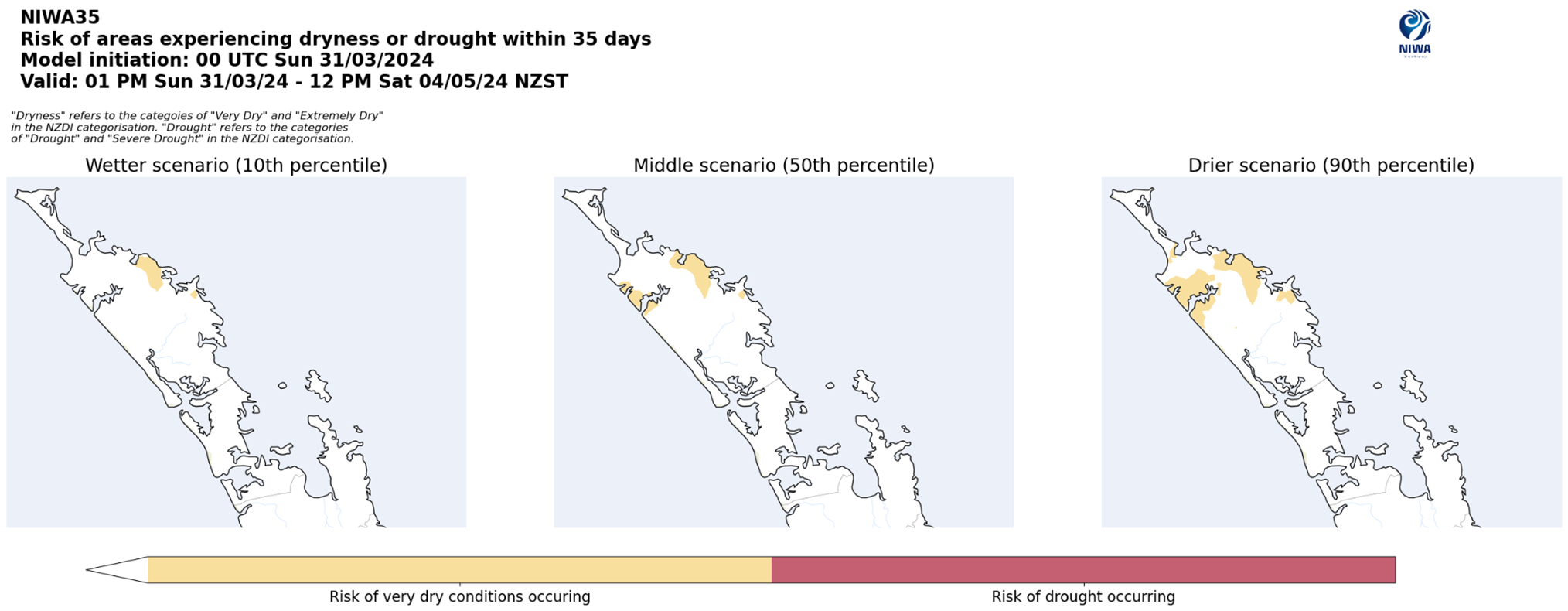
NIWA35 Rainfall anomaly model for 31 March 2024 – 4 May 2024.
Rainfall
March was the third dry month in a row, with many regions beginning to feel the lack of rain. Percentage wise, the region averaged 44% of what would usually be expected in March. Poutō Peninsula and Tutamoe were the only areas to get over the expected March rainfall – Tutamoe 120%, Ngatawhiti Road 118% and Poutō Point 116%.
The east received the least rainfall with Glenbervie Forest in Whangārei recording 11%, Ngunguru 13%, Ohaeawai 15% and Whakapara at Puhipuhi 18%.
Rainfall (% of Median) for March 2024 across Northland with a range of 120% to 11%
Standardised Precipitation index (SPI)
The Standardised Precipitation Index (SPI) standardises the rainfall recorded in the region. Between January and March, the SPI shows that the region is “Moderately Dry” to “Severely Dry”, with some areas in the northeast “Extremely Dry”. Other the last six months, from November 2023 – March 2024 the region is a mixture of “Near Normal” to “Moderately Dry”.
3-month (January - March 2024) and 6-month (October 2023 – March 2024) SPI maps
River flow
River flows for March were generally “Low” or “Very Low” for this time of year across Northland. In the far north and the south of the region there are a few catchments that are maintain that are closer to normal.
Monthly percentile River Flows for March 2024
Groundwater
Across Northland aquifers, there is large amount of variation in water levels. Ranging from “Normal” to “Extremely Low”.
| Aquifer | Status | Percentile |
| Aupōuri | Above normal | 60th+ |
| Taipā | Below normal | 25th-40th |
| Russell | Extremely low | 0-5th |
| Kaikohe | Low | 10th-25th |
| Poroti | Normal | 40th-60th |
| Whangārei | Normal | 40th-60th |
| Mangawhai | Normal | 40th-60th |
| Marsden - Ruakākā | Normal | 40th-60th |
| Ruawai | Low | 10th-25th |
Groundwater levels for March 2024
Soil Moisture
Soil moisture levels across Northland are all below average, with March patterns and levels continuing from February. All sites currently have no “available water” for plants (more than 75 mm deficit). Plant growth is likely to be very slow limited to small bursts when showers pass through, and wilting of tender or shallow rooted plants is likely.
Historically soil moisture would have begun to recover through March and April, however with the expected outlook for April recovery is likely to continue to be delayed this season. The soil moisture deficit is calculated based on incoming daily rainfall (mm), outgoing daily potential evapotranspiration (mm), and a fixed available water capacity (the amount of water in the soil 'reservoir' that plants can use) of 150 mm” (NIWA).

